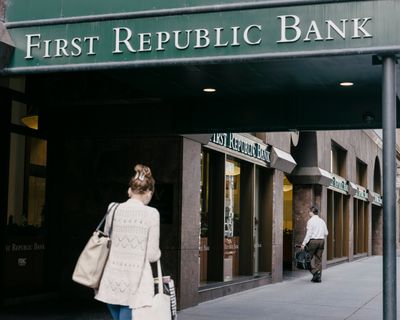First Republic’s shares slide as its fate remains uncertain

Shares of First Republic Bank resumed their punishing decline Friday, adding to a string of losses this week that have come as doubts over the future of the regional lender intensified.
The company’s stock price dropped more than 43% to $3.51 per share, bringing its losses since Monday to more than 75%.
First Republic has failed to fully stabilize itself since it became engulfed by the crisis that led to the failure of Silicon Valley Bank in California and Signature Bank in New York in March. Those banks were seized by regulators after depositors rushed, in a span of just a few days, to pull their money as they worried about their long-term viability.
Although it was also seen as a bank in trouble, San Francisco-based First Republic won brief respite when 11 of the largest U.S. banks came together to inject $30 billion of deposits into the lender. But the precariousness of its situation came back into focus this week when it reported earnings results and told investors that it had seen the outflow of more than $100 billion in deposits since mid-March.
Now, a mix of doubt and speculation cloud the path ahead, unnerving investors. The bank has been in conversations with regulators, policymakers and industry peers about a rescue package for weeks without managing to hash out a long-term solution.
The stock fell almost 50% on Tuesday, following the dour profit update from the company Monday. It dropped again Wednesday, before recovering slightly Thursday. With Friday’s drop, the share price has fallen from more than $120 per share at the start of March – a drop of more than 95% that has wiped roughly $22 billion from First Republic’s market valuation.
First Republic’s troubles, though, seem contained, unlike in March when investors feared a cascading effect of bank failures. That’s in part because other lenders have also reported earnings, and shown themselves to be in relatively good health.
The S&P 500 rose 0.8% on Friday, with every bank apart from First Republic rising and most outperforming the broader index. Even the KBW regional bank index, an index of smaller regional lenders in the United States, rose 1.2% on Friday, ending flat for the week.
“The market has a pretty short attention span,” said Ron Temple, chief market strategist at Lazard, adding that he thinks the potential for systemic issues arising from another bank failure are being underappreciated. “Most investors seem to have moved on,” he said.
Instead, the focus has shifted to a slew of robust profit updates from companies across the country. The S&P 500 was on course to close out the week 0.9% higher, up 1.5% for the month.
This article originally appeared in The New York Times.